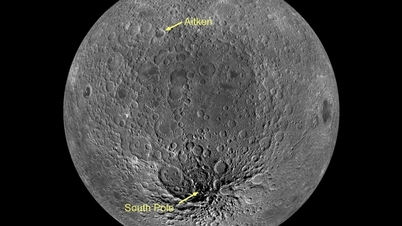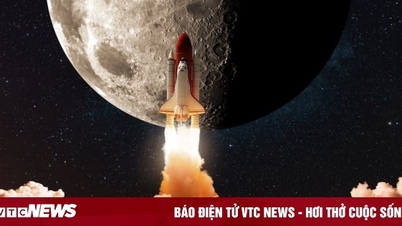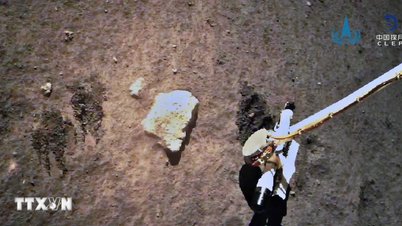
The Moon is gradually moving away from Earth. A slow but relentless journey over the past 4.5 billion years - Photo: PIXABAY
This number may sound small, but if calculated on a time scale of millions to billions of years, this is an important change, helping people better understand the history of the formation of the Earth and the Moon as well as predict the future of this entire system.
How far is the Earth from the Moon and how is it measured?
Determining the distance between the Earth and the Moon is not based solely on conventional observations. Scientists use a technique called Lunar Laser Ranging.
During the Apollo missions and some Soviet spacecraft, humans placed reflectors on the surface of the Moon. When a laser beam was fired from Earth to the Moon, it would bounce back. By measuring the time it took for the light to travel and return, scientists could calculate the distance to within a millimeter.
The results show that the current average distance is 385,000km.
However, the Moon does not orbit the Earth in a perfect circle, but in an elliptical path, causing the distance to vary by more than 20,000km. This is why there are times when a full moon appears larger than usual, a phenomenon known as a supermoon.
Tides: the force that pushes the Moon away
The main reason for the Moon's drift is tidal forces. The Moon's gravitational pull causes the Earth's water to bulge out, forming two "humps," one facing the Moon and one facing away.
However, because the Earth rotates faster than the Moon orbits it, these two bulges are not aligned but are pulled forward. This deflection creates an additional gravitational pull, pulling the Moon further out in its orbit and helping it move faster.
In return, Earth sacrifices by slowing its rotation. That means our days are getting a little longer. The rate of change is tiny, just a few thousandths of a second per century, but when added up over millions of years, the difference becomes noticeable.
Going back in time, when the Moon was first formed about 4.5 billion years ago, it was very close to Earth as the result of a giant collision between the early Earth and a celestial body roughly the size of Mars.
At that time, the Moon appeared in the sky many times larger than it does today and the tidal effects were many times stronger.
Evidence from ancient geology and biology also confirms this. Fossils of seashells show that 70 million years ago, a day on Earth lasted only about 23.5 hours, shorter than it is today. This fits perfectly with the prediction of the process of the Moon gradually moving away from the Earth and slowing its rotation.
Future prospects
If this process continues, the day will come when the Earth and the Moon will enter a state called “double tidal locking”: the Earth will rotate on its axis so slowly that it matches the Moon’s rotation around the Earth. Only half of the Earth will always be able to see the Moon, while the other half will never see it.
However, this scenario will not come true. In about a billion years, the energy emitted by the Sun will increase, causing the Earth to heat up and the oceans to evaporate. As the oceans disappear, so will the tidal force that is the main force causing the Moon to drift away.
Further out, a few billion years from now, the Sun will swell into a red giant, likely engulfing and destroying both the Earth and the Moon.
The Moon’s retreat from Earth at a rate of just a few centimeters a year may seem insignificant to everyday life. But on a astronomical scale, it is a crucial process that helps scientists better understand the evolution of our planet.
It not only explains common phenomena such as tides, supermoons or solar eclipses, but also reveals a panoramic picture of the Earth's billion-year history and predicts the fate of the Earth-Moon system in the distant future.
Source: https://tuoitre.vn/mat-trang-ngay-cang-roi-xa-trai-dat-dieu-gi-dang-xay-ra-20250916175347233.htm





![[Photo] Lam Dong: Images of damage after a suspected lake burst in Tuy Phong](https://vphoto.vietnam.vn/thumb/1200x675/vietnam/resource/IMAGE/2025/11/02/1762078736805_8e7f5424f473782d2162-5118-jpg.webp)

![[Photo] President Luong Cuong receives US Secretary of War Pete Hegseth](https://vphoto.vietnam.vn/thumb/1200x675/vietnam/resource/IMAGE/2025/11/02/1762089839868_ndo_br_1-jpg.webp)

































































































Comment (0)